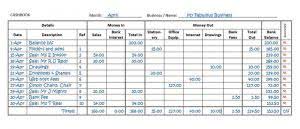
As we move forward, we will explore the subsequent stages in the construction process, each bringing us closer to realizing the envisioned structure. The construction process can be defined as the series of steps, procedures, and activities involved in designing, planning, and building a structure. Primarily, it ensures that the envisioned structure is built to specifications, meeting all functional, aesthetic, and regulatory requirements.
Understanding the Purpose of CWIP
- Once construction is completed, the total CIP amount is transferred from the CIP account to a permanent asset account (e.g., “Buildings” or “Infrastructure”).
- Construction in progress is a critical aspect of financial management in the construction industry.
- If a company does not track these costs accurately, its finance department may wonder why the company is generating expenses that do not immediately produce profits.
- Attention to detail during this stage is critical as it significantly impacts the look and feel of the space, ensuring that the finished product meets the client’s expectations and design specifications.
- When these goods are completed, they are often transferred to inventory to later to be treated as a cost of good sold when purchased by a customer.
Early installation allows plants to establish before the building is occupied, enhancing the landscape’s maturity and beauty. Landscaping is done alongside general construction, with a focus on creating functional and aesthetically pleasing outdoor spaces. A detailed landscape design may involve various elements such as lawns, flower beds, water fountains, and seating areas, contributing to the building’s exterior environment. This step involves installing tiles, painting, ceiling grids, fixtures, fittings, and fixed furniture. Detailed drawings and finish schedules guide this process, ensuring that the finishes align with the design vision. Interior finishes include elements like wardrobe cabinets, carpentry, reception desks, and light fixtures.
Asset Liquidity
Generally accepted accounting principles (GAAP) requires the percentage of completion in journal entries whenever possible to account construction in process for construction in progress. Firstly, financial reporting for CWIP involves appropriately categorizing and disclosing the costs and revenues related to the ongoing projects. This includes segregating direct costs, indirect costs, labor expenses, equipment costs, and any other relevant expenditures in a manner that distinguishes them from completed projects.
What Is Construction in Progress?
Businesses must prepare accurate, up-to-date financial reports that account for their expenses and profits. A balance sheet shows a company’s net worth at any given time and includes all of its assets, even those not currently in use. Construction work-in-progress accounting refers to the record-keeping of all expenditures that accrue in constructing a non-current asset. An accountant will report spending related to the construction-in-progress account in the “property, plant, and equipment” asset section of the company’s balance sheet. Understanding Construction in Progress GAAP is essential for construction professionals and businesses undertaking large-scale capital projects.

Integrating MEP systems with the building’s design ensures efficient operation and maintenance, contributing to the overall building performance. Planyard streamlines CIP accounting by making it easier to stay organized, reduce manual errors, and keep each project’s financial status clear. It simplifies tracking so you can confidently manage budgets and ensure accurate, reliable financial records — all while focusing on successful project delivery. When the project is complete, transfer the CIP balance to a fixed asset account like “Buildings.” This signifies the asset’s transition to operational use, and depreciation begins. Moreover, financial reporting for income summary CWIP should comply with applicable accounting standards and regulatory requirements to ensure consistency and comparability across different construction companies. Such compliance fosters credibility and confidence in the financial information presented, facilitating informed decision-making for investors and other interested parties.
Percentage of Completion Journal Entries

He is an expert on personal finance, corporate finance and real estate and has assisted thousands of clients in meeting their financial goals over his career. While these terms are often used interchangeably, they have distinct meanings in the construction and accounting fields. By sending notices early and paying attention to the project Law Firm Accounts Receivable Management state’s deadlines, contractors improve communication on the job, and ensure they have lien rights — if and when they need them. Contractors can take many steps to get paid faster, and they are often most effective when followed simultaneously. One of the most effective ways to reduce financial risk and improve cash flow is by protecting their right to file a mechanics lien.
- Also, the fear of bankruptcy doesn’t fade until the job wraps up and the checks clear the bank.
- Retainage is also still an issue, but with the volatility of materials pricing (another risk), it can really crush a subcontractor’s cash flow.
- It also helps in building a strong relationship with the client, which can lead to future collaborations.
- Navigating the intricate journey of building construction requires more than just tools and materials; it demands a thorough understanding of each critical phase.

This practice, however, distorts financial reports by misrepresenting the true profitability of the company. Construction-work-in-progress accounts can be challenging to manage without proper training and experience. Most companies hire a chief financial officer to maintain these records and avoid costly accounting errors. This percentage completion appropriation method is most common when a contract of delivering a large number of similar assets is made.


Nema komentara